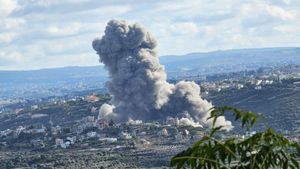Escalation of violence between Israel and Hezbollah has reached alarming levels, with recent Israeli airstrikes resulting in the deaths of at least 40 people in eastern Lebanon, according to the Lebanese health ministry. These attacks have caused both human tragedy and cultural destruction, as historical sites have been damaged amid the hostilities.
On Wednesday, Israeli military operations focused on the Baalbek and Bekaa regions, targeting what they described as operatives and infrastructure belonging to Hezbollah, the Iran-backed militant group. The strikes were part of Israel's broader campaign to dismantle Hezbollah's military capabilities, especially following increased rocket fire from Lebanon.
Lebanon’s culture minister announced significant damage to the famed Ottoman-era structure known as the Manshiya building, located near the Roman ruins of Baalbek, which is designated as a UNESCO World Heritage site. Minister Mohammad Mortada lamented the “irremediable loss” of this cultural monument, emphasizing its importance not only to Lebanon but to global heritage.
The Israeli military has issued warnings for evacuations, reportedly targeting Hezbollah command centers and weapons depots. Recently, strikes also hit southern suburbs of Beirut, where civilian casualties have raised concerns about the conflict's impact on non-combatants.
Witnesses recounted harrowing experiences during the airstrikes. One resident of Barja, where over 30 bodies were retrieved following the attacks, expressed deep anguish as he surveyed the wreckage of what used to be his home. He recounted how he managed to save his family amid the chaos: “I removed [the rocks] and handed my son to the civil defense through the window. I carried my wife and came downstairs.”
Sadly, reports indicate the deceased included seven women and three young children, with the youngest victim identified as merely seven months old. The lack of prior evacuation warnings has sparked outrage, as residents feel caught between military operations and the dangers posed to their lives.
Throughout the day, the toll from the violence continued to rise. By evening, the Lebanese health ministry reported 40 who had perished and over 50 injured across various strikes. The situation remains dire as airstrikes targeted numerous facilities belonging to Hezbollah, which the Israeli military claims is necessary to neutralize threats to its northern border.
Adding to the hostility, Hezbollah launched approximately 170 rockets targeting northern and central Israel, resulting in casualties on the Israeli side as well. One family tragically lost their son, Sivan Sade, aged 18, who died due to shrapnel wounds from a Hezbollah rocket strike. Sade was working on the family farm when the attack occurred, illustrating how the conflict disrupts lives beyond the immediate combat zones.
Reports of infrastructural hits near Tel Aviv also alarm Israeli officials. A rocket landed close to Ben Gurion International Airport, raising concerns about air traffic safety, though airport operations continued unaffected.
The recent clashes represent the escalation of conflict between Israel and Hezbollah after years of simmering tension exacerbated by the war following Hamas's devastating attack on Israel on October 7, 2023. This incident triggered Hezbollah's rocket offensive, significantly heightening cross-border hostilities.
The two sides appear locked in a brutal exchange, with Israel intent on eliminating Hezbollah fighters and leadership responsible for rocket fire. The Israeli military claims to have killed around 60 Hezbollah fighters, emphasizing its focus on dismantling the group's operational networks to restore security to northern Israeli communities.
Hezbollah's response has been relentless. Naim Qassem, the group’s secretary-general, declared their commitment to combat, asserting their forces are prepared and willing to continue fighting. He emphasized, “Only the battlefield can stop this war of aggression.” Such statements underline the group's determination to counter Israeli military objectives.
This conflict, generating widespread international attention, continues to evolve with grave humanitarian consequences, as civilian areas bear the brunt of the violence. The Lebanese authorities report at least 2,400 fatalities and over 1.2 million displaced residents across Lebanon since the conflict's resurgence. The domestic turmoil echoes throughout the region, as historical and cultural sites also suffer irreparable damage.
Those living within the conflict zones face uncertainty as military engagements worsen daily life. Distrust and fear have seeped deeply within communities, making daily survival doubly challenging amid the persistent threat of airstrikes and rocket attacks.
Moving forward, regional and international observers maintain close scrutiny. Diplomacy seems ever more necessary as the dual narrative of military actions continues. With Lebanese and Israeli civilians suffering the dire consequences, the hope for ceasefires or diplomatic resolutions hangs by a thread, increasingly urgent amid the rising death toll and the destruction of irreplaceable cultural heritage.
The escalation encapsulates the dire situation where heritage, humanity, and geography collide tragically, inviting questions not only about the future of peace but the preservation of past legacies marred by conflict.



